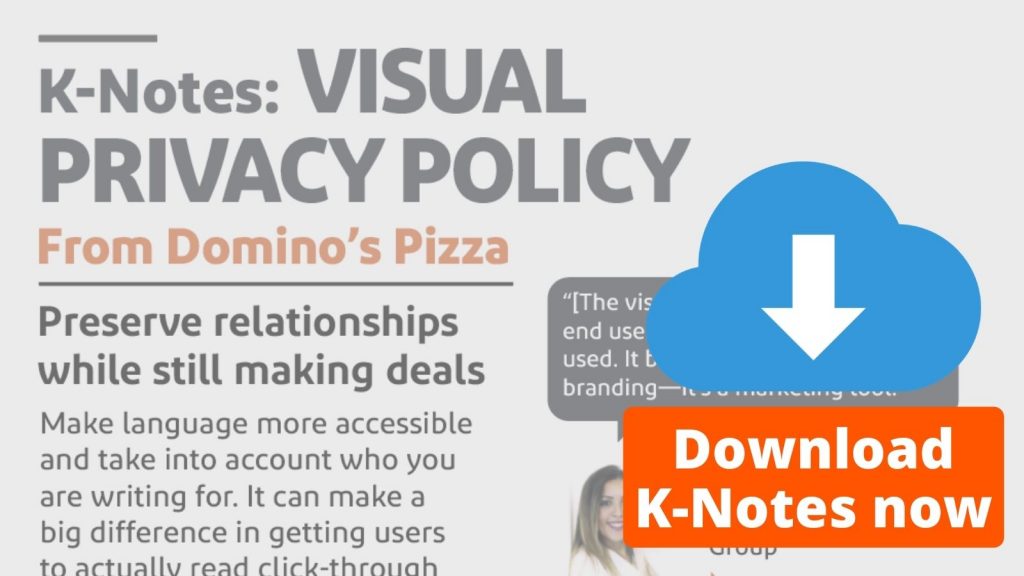Contracts facilitate transactions, but they can also slow them down. That creates tense relationships. Can we rethink contracting to more effectively guarantee parties’ wishes while preserving relationships and getting deals done? According to one legal content creator, we could start by making contracts more visual. To demonstrate, attorney Sarah Ouis brings her art to the Domino’s UK Privacy Policy.
Questions in this episode
- How effective are GDPR privacy disclosures if no one reads them?
- What is the process for turning complex agreements into visual representations?
- Can contracts actually encourage future consumer transactions?
- Are visual contracts useful in business-to-business transactions as well?
Domino’s Pizza
The European Union’s General Data Protection Regulation (GDPR) created several privacy-related obligations for companies operating in Europe, including in the UK. Those requirements apply to international companies like Domino’s Pizza, a Michigan-based corporation with franchise locations throughout Europe.
For most people ordering pizzas in the 21st Century, they’ll encounter the Domino’s Privacy Policy when ordering online. The document becomes a standard click-through agreement: required, but fairly removed from the experience of quickly ordering food on a computer or phone application.
As a business-to-consumer transaction, the Domino’s Pizza purchase is exactly the context in which the GDPR aims to intervene. But to protect pizza-buying consumers, those consumers need to actually read the privacy disclosures.
A More Visual Contract?
According to legal content creator Sarah Ouis, condensing and modifying the Domino’s Privacy Policy into a more visual asset will entice more consumers to read the document.
In this episode of the Contract Teardown show, Sarah walked through her process for converting complex legal documents into more engaging visual experiences.
Her process broadly follows three steps:
- Simplifying contract language to remove legalese and focus on plain language expressions;
- Converting the simplified language to a bulleted list using expressive icons; and
- Condensing the language and icons into documents with fewer pages.
Let’s walk through the Domino’s UK Privacy Policy to see how Sarah applies her method.
How to Better Communicate Party Relationships
In the “Who Are We” section, Domino’s shares the basic contact information that the GDPR requires.
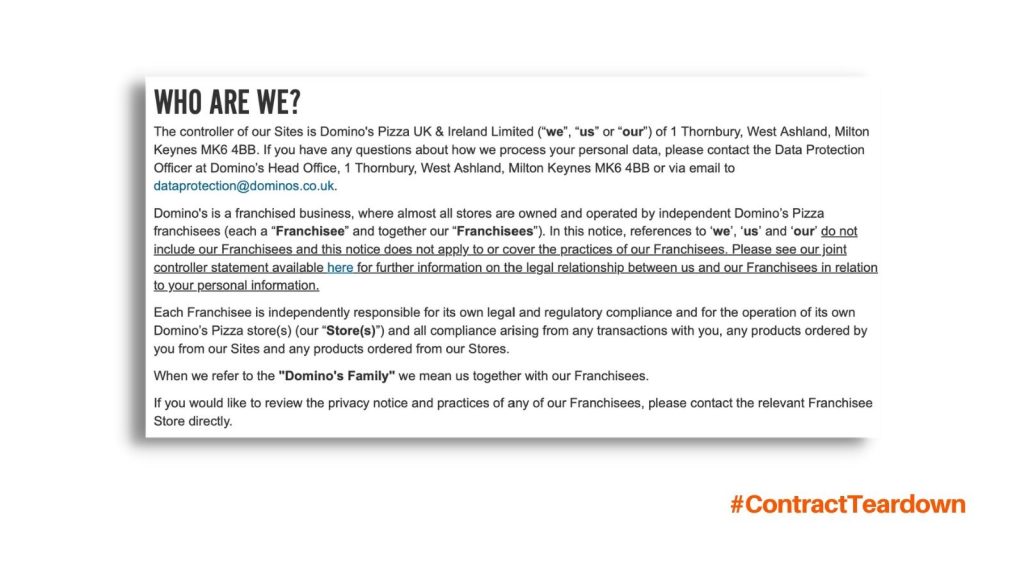
The disclosures seem fairly straightforward, but Sarah noticed that this section includes terms that might be unfamiliar for the pizza-buying public.
She began by simplifying the language. She questioned what Domino’s wanted to communicate and who the information is for. That led her to write less for the experienced legal brain and more for the rushed and hungry buyer. She simplified language about franchises (a legal term of art) and focused on accessibility.
Here is her first iteration:
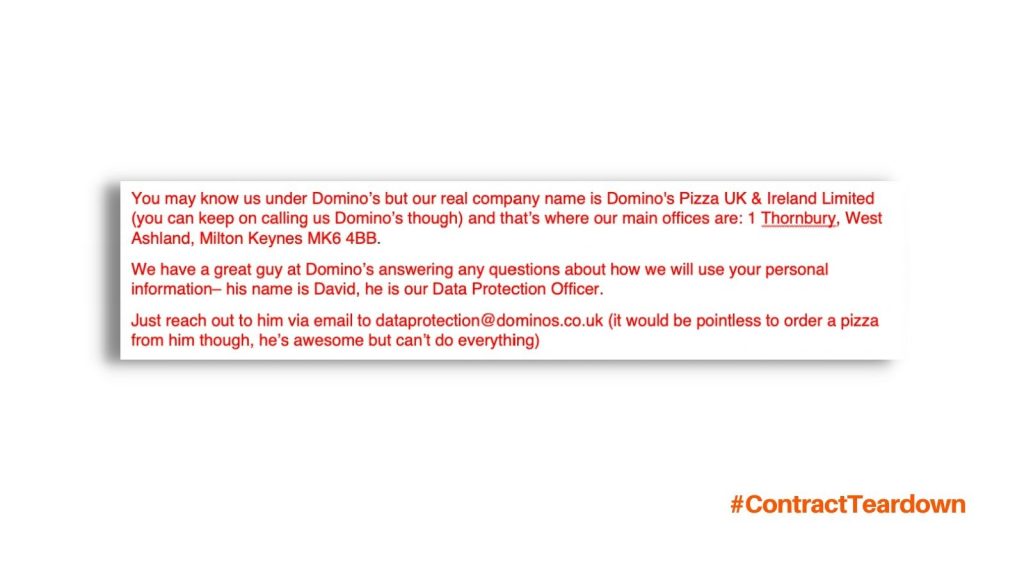
Improving Data Transparency
Sarah went through a similar process with the section titled “What information do we collect and how do we collect it?”
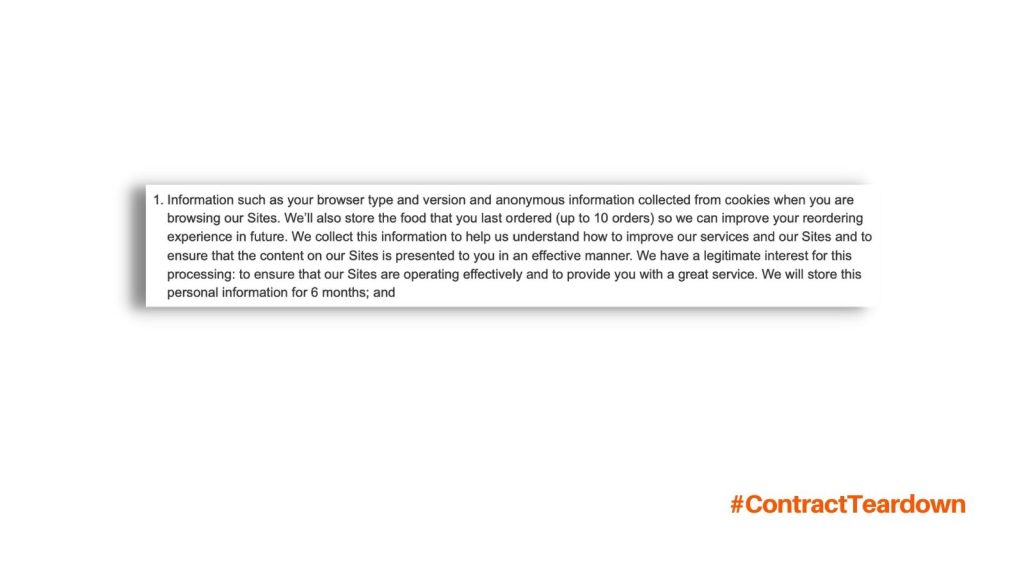
She looked for terms that might not be familiar to every consumer and added helpful examples. Here you see that she named Chrome and Safari as possible internet browsers.
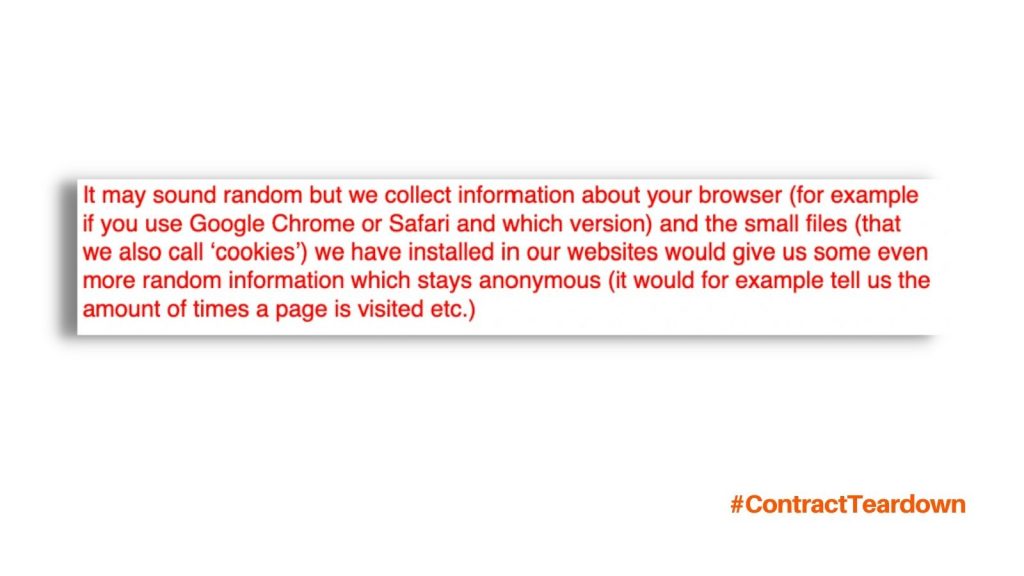
As Sarah explained it, she aimed for a reading level similar to most blog or news sites—generally a 7th-grade reading level in the United States—to ensure comprehension. This, she argued, better serves the purpose of the GDPR legislation.
Adding Visual Elements to Contracts
In her next iteration, Sarah turns her simplified language into bullet-point style lists. She incorporates icons to help her begin visualizing her final documents.
Here she converts the “Direct marketing” section into simple statements accompanied by easily-digestible visuals.
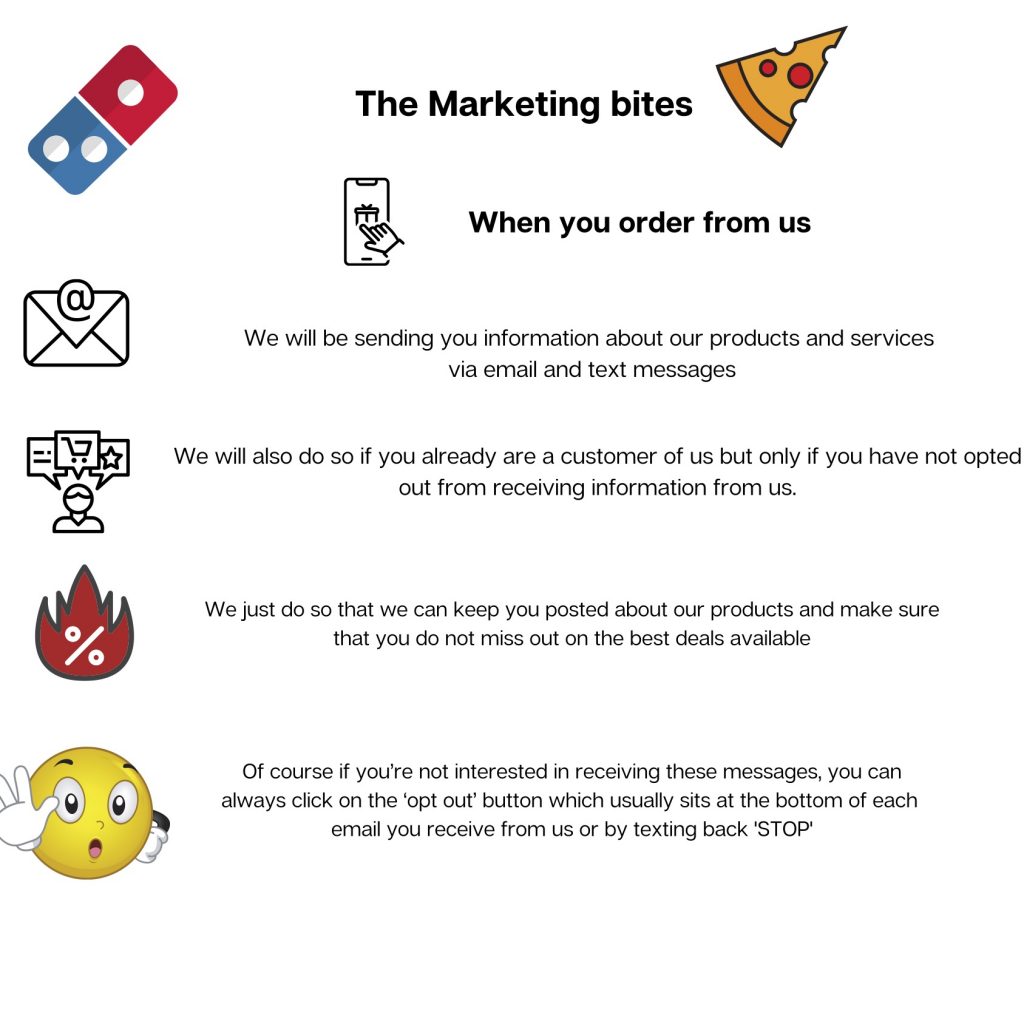
As Sarah pointed out, however, these icons can add to the complexity of a document rather than take it away. She doesn’t use the icons as a final step but as an inspiration that gets her started with visualization.
Finalizing Your Visual Contract
In her final step, Sarah converts her summarized language and visual cues into as few documents as possible. She really stretches her creativity as she condenses complex legal ideas into just a few pages.
Here is her final visualization of the “Who Are We” section:
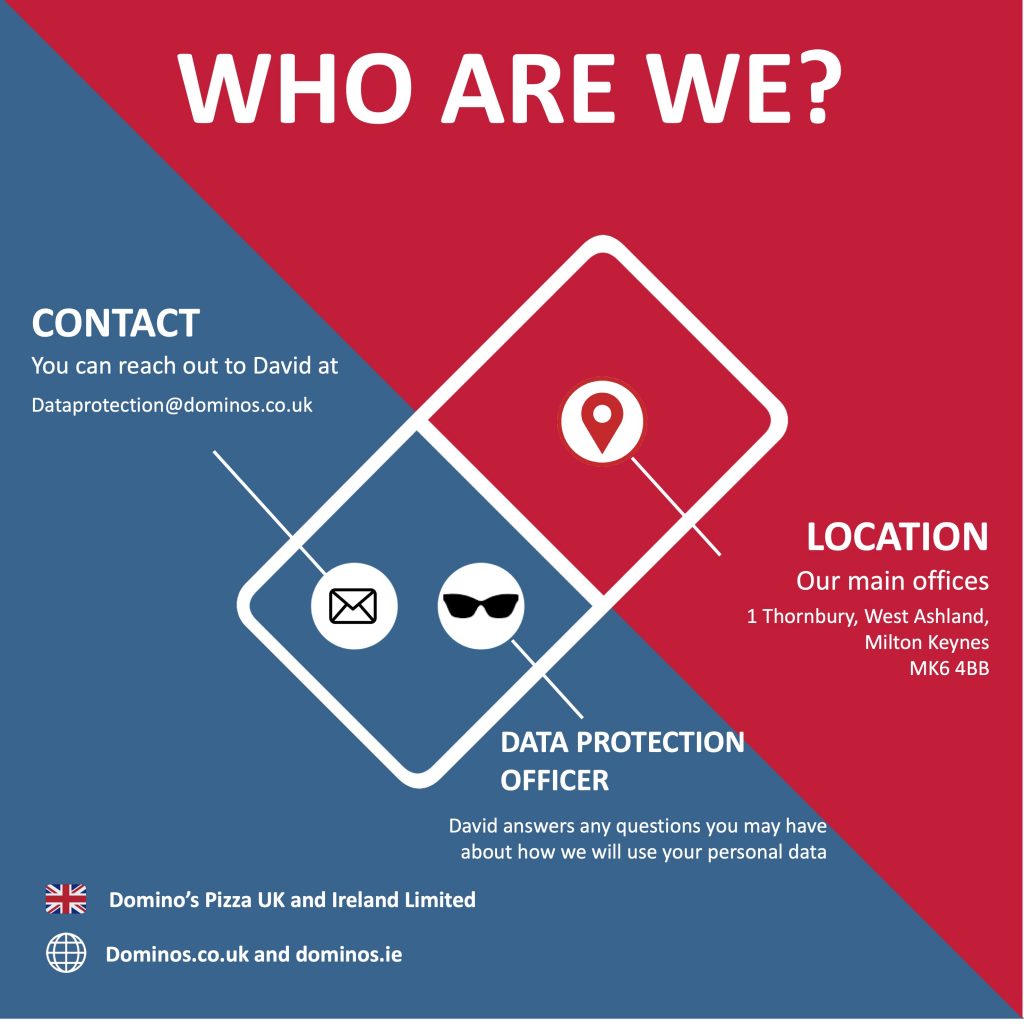
As you can see, this document gives the consumer everything she needs to contact Domino’s UK for privacy information, and to report the company to the appropriate GDPR authorities, if necessary. The visual accomplishes the original document’s purpose but in a way that will more likely engage a consumer.
And here is Sarah’s final visualization regarding the use of private information:
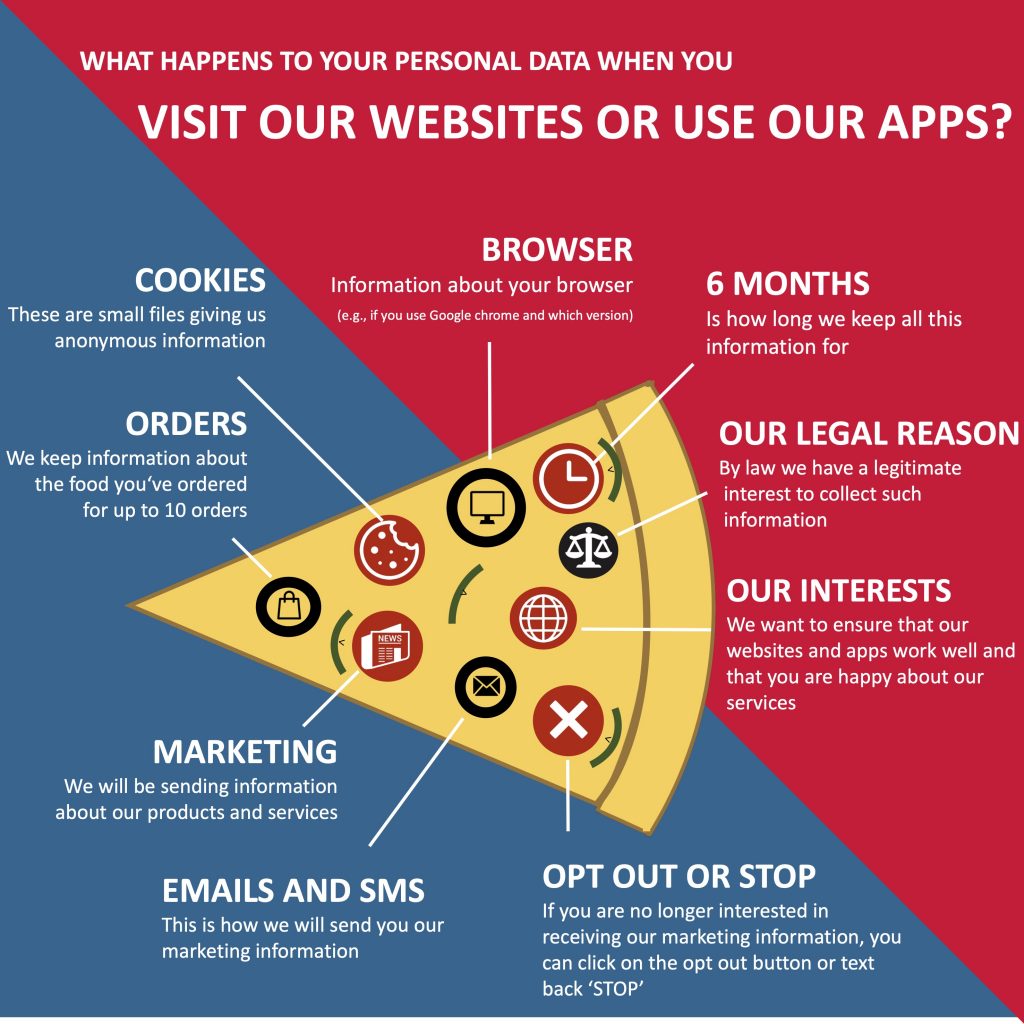
Again, Sarah has condensed complex information as much as she can. As she described it in her Teardown interview, this icon-driven image allows for live links in case consumers want to dig deeper. This complies with the regulating authority’s recommendation that privacy disclosures be ‘layered,’ or explained in different ways and level of granularity.
Contracts As Marketing Tools?
Sarah’s work threads the needle between contracting requirements and engaging consumer experiences. As she explained, this improves the relationship between buyers and sellers.
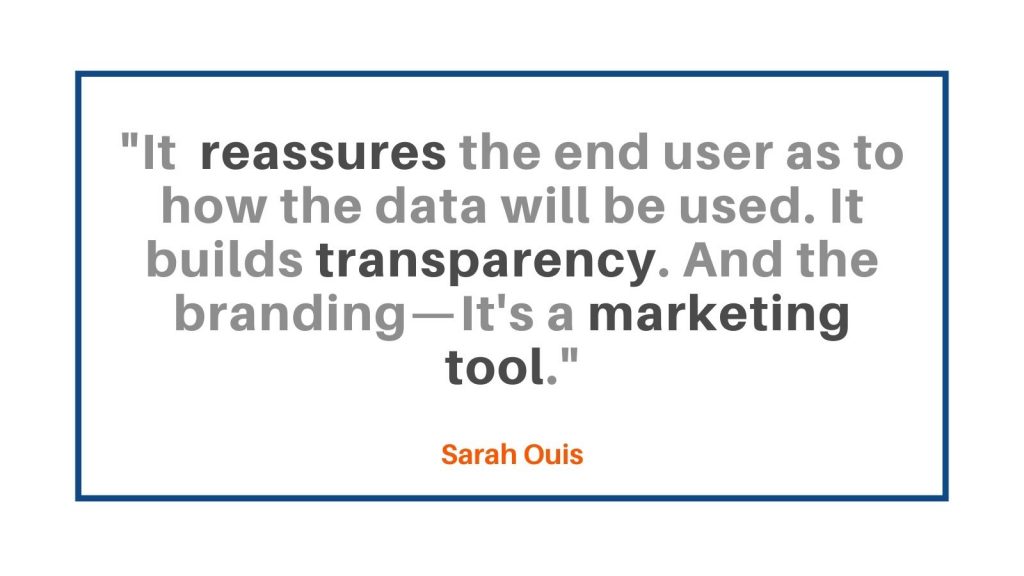
As Sarah noted, consumers who are in the middle of a pizza-buying experience see standard click-through agreements as an interruption. Lawyers may believe that the jolt underlines the ‘legalness’ of the agreement, hoping that they’ll stop and pay attention. But if the contract experience is too far removed from the buying experience, it could disengage the consumer.
Instead, as Sarah explained, contracts can serve as part of the marketing experience. Her visuals incorporate Domino’s branding and build trust.
Efforts like Sarah’s help preserve relationships with buyers while also facilitating transactions. That could be the dream scenario for corporate clients and their counsel.
Show Notes
THE CONTRACT: Domino’s Privacy Policy
THE GUEST: Sarah Ouis works in commercial legal counsel with experience in Tech and Pharma industries, mainly in commercial and data protection related issues. She is passionate about legal design and the idea of making legal related content accessible. You can look her up on Instagram @verylawyerproblems or on LinkedIn.
THE HOST: Mike Whelan is the author of Lawyer Forward: Finding Your Place in the Future of Law and host of the Lawyer Forward community. Learn more about his work for attorneys at www.lawyerforward.com.
OTHER RESOURCES: Oliver Hart’s commentary on contracts prioritizing relationships over transactions
Transcript
Sarah Ouis [00:00:00] Consumers or generally speaking, anyone who would have to give away their personal data, have to be informed. Welcome to the Contract Teardown Show from Law Insider, where legal experts tear down contracts from some of the most well-known companies and high profile executives around the world.
Mike Whelan [00:00:21] In this episode, in-house counsel and legal content creator Sarah Ouis tears down the Domino’s Pizza privacy policy. She does it in a unique way, though, showing us her process for turning complex legal information into accessible visuals for consumers. It’s a fascinating look forward for contract drafters who prioritize understandability. So let’s tear it down.
Mike Whelan [00:00:45] Hey, everybody. Welcome back to the contract Tear Down show. I’m Mike Whalen. The purpose of this show is exactly what it sounds like. We get together, we beat up contracts with smart friends like Sarah Ouis over here. Sarah, how are you today?
Sarah Ouis [00:01:00] Hey, Mike, I’m doing well, how are you?
Mike Whelan [00:01:02] Good. I spent most of my morning chasing squirrels off my back porch. You know what they said to me? They said plant mint and then the squirrels won’t dig anywhere in your garden. So hilariously, I went outside today and the one plant that was dug up was the mint plant. So I’m losing at life. But we’re trying. Our covid hobbies are lasting. Today guys, we’re going to talk about a document from Domino’s. It is this document. Let me share it real quick. This is the privacy policy. And as you see, there are many words that consumers will never read. So, Sarah, why are we talking about this document? Where does this thing come from? When are lawyers going to see it?
Sarah Ouis [00:01:43] That’s a great question, Mike, so I guess the reason really being that privacy notice is a is a legal requirements and the European legislation and data protection legislation. So consumers or generally speaking, anyone who would have to give away their personal data have to be informed in how the data is going to be used. Right now, the reality is that most of the time they would be informed in such a way that is legally worded and that clearly, as you was saying, people without a legal background won’t necessarily understand, let alone read. So that’s obviously the purpose of that, having chosen in these documents.
Mike Whelan [00:02:25] Right. So we’re going to have a conversation about simplifying this thing. That’s the gist of the conversation. Sarah, what about you? What’s your background? What are you bringing to this document from from Domino’s?
Sarah Ouis [00:02:37] So I’m a commercial lawyer, so I do work in-house and I have a commercial and data protection background. And in addition to that, I’m a legal content creator and I’m very passionate about making legal content a lot more engaging and accessible and leveraging my creativity to to that extent. So that’s the reason why I was passionate about the idea of taking a privacy policy like the one of Domino’s, which is obviously an iconic brand to transform it and make it a lot more digest, pun intended.
Mike Whelan [00:03:13] Creativity from a lawyer. You’re a mad person. OK, here’s what we’re going to do. We’re going to focus on a couple of sections and I’ll show these these to you guys real quick. In the privacy policy, there are a couple of sections that are relevant. This who are we section and this what information do we collect and how do we collect it? And a bit in the direct marketing. So these are sort of the things that often come up in these privacy policies and as you said, are important for the legislation in the U.K. and some in the US as well, being clear about who you are, who they can sue if that if something goes wrong. And then also what are you doing with my stuff? So I know if I can sue you. Right. So we’re going to go through those. What was interesting about this, you and I talking about this is you went through a process that I found interesting. It was sort of a text first, then a visual than a really visual. So we’re going to talk about how you went through that process. So to do that first thing, let’s talk about this “Who are we” section. When you look at this text in the original document, it says, The controller of our sites is Domino’s Pizza UK and Ireland Ltd. We our of one Thornsberry W, Ashlynn, Milton Keynes, blah, blah, blah. If you have any questions about blah, blah, blah, blah, blah, blah. Right. Like just a lot of words, you went and revisited this. Tell me about the process for how you got to this initial text, which is much more, I would say website speak, write like blog speak.
Sarah Ouis [00:04:40] Yes, so. So as I was saying, so I’ve had really two versions of it. So the first one being, how can I simplify, how can I simplify the essence of the document? So as you were saying, I mean, if you look at that in the documents, you know, who are we? The controller of our sites is I mean, if you’re not lawyer or if you don’t have a privacy background, you don’t even know what a controller is. Right. So I went through that process of starting with simplifying as opposed to just the controller of our sites is, well, who is the legal organization you are talking to, basically? So that was my thought process, simplifying the language itself. And then because at the end of the day, you know, it’s just a way to introduce the organization.
Mike Whelan [00:05:27] Right now, I want to give credit to the language that you wrote you sent to me. You may know us under Domino’s, but our real company name is Domino’s Pizza UK, so you started with sort of where they’re coming from and started to move them along. You gave the address, which is legally what that’s what you’re actually trying to get to people is the address. You you talked about the data protection officer and you stated it as if he’s a he’s an actual person. You can contact this guy. Here’s his email address again. Much more accessible to I know where you’re coming from. I know you’re landing on this document because you’re ordering a friggin pizza. You don’t want to read a big, long thing. So call David right
Sarah Ouis [00:06:11] Call David if you have information about your personal information and the way we use it. But yes, the idea is to simplify it, you know, again, as opposed to say the controller is. Yeah, I just said you may know us as Domino’s, but our real company name is Domino’s Pizza, you can Irelands Ltds, for instance, and as you were saying, personifying who the data protection is because he’s an actual individual and he is there to answer any questions. So it simplifies the language and it does build trust as well from the end user perspective.
Mike Whelan [00:06:46] Hey, everybody, I’m Mike Whalen, I hope you’re enjoying this episode of the Contract Teardown Show. Real quick, I want to ask you to do me/you really a quick favor. Look down below. You’ll see a discount code to join the law insider premium subscription. When you do that, you get access to more content like this. You’ll see webinars, daily tips on contract drafting, not to mention access to the world’s largest database of sample contracts and clauses. It will help you write better contracts faster. If you want to do it right now, there’s a code below. So get there. Also, if you’re part of a larger team, if you’re in-house or in a law firm, just email us. We’re at sales@lawinsider.com we’ll make sure you get a deal as well. Come join us in the community. The code is below. Let’s get back to the show.
Mike Whelan [00:07:32] Yeah, going on in the document, they said each franchise is independently responsible, responsible for its own legal and regulatory compliance and for the operation of its own Domino’s Pizza stores and all compliance arising from any transactions with you, any products from you, et cetera, et cetera. Again, you jump from that to what are they trying to do? Right. That’s what I’m getting from your process, is what are you trying to do here, you know, as a writing exercise? What are you trying to communicate and who are you trying to communicate it to? And you shifted that language to OK, this is where it gets messy. But to cut a long story short, we do not own all the Domino’s shops around the world. So assuming that’s your framework that you’re saying, who’s this for, what are we trying to say to them? How do you select that out of a document like this? What’s the take home message kind of process? How do you find that?
Sarah Ouis [00:08:24] So I think when I first came across this language, as you said, the concept of franchise in itself isn’t necessarily known for the everyday Joe, if you will. And that’s where, you know, I the way I can follow this language is very much by thinking, OK, you know, clearly it’s a bit complex. So I’m setting the framework. That’s why it gets messy. However, it’s not that it’s not that complicated, but you have to understand, the Domino’s don’t own all the shops, all the shops around the world, which could be a fair assumption. If you just see, you know, the Domino’s brand and logo, you may just assume that you know that one know one and the same legal entity or part of the same corporate organization. So, again, the idea is to introduce the franchisees and the franchise to concepts in a much more easy to understand format.
Mike Whelan [00:09:18] So I’m thinking about process again, like this is ruminating in the back of my head as I’m continuing to process your genius on this. Let’s scroll down to what information do we collect and why do we collect it? This is to your point earlier in terms of legal requirements, really important that the whole point in that legislation is that the buyer understands, the user understands what’s happening with my data in their original, which I should give them some credit. By the way, their language is not nearly as dense as some documents that I’ve seen right now. So I want to give them some credit. But it is still, you know, written for, you know, maybe a pretty smart legal industry person. The way they write about this, when you visit our sites, we may collect information such as your browser, browser type and version and anonymous information collected from cookies, which you are when you are browsing our sites. Again, a lot of terms that somebody ordering some pizza might not understand. What did you think about what were you trying to focus on when you ran into this language about the information that’s collected?
Sarah Ouis [00:10:26] That’s a great question. So here really, I mean, as you were saying, when you order a pizza, you don’t necessarily anticipate that, you know, your information about your browser might be connected and what is the browser anyway? You know, if you think about the whole concept of a browser site and that’s why they have the legal obligation to inform people. Again, the idea is how you do it and how lawyers can leverage their creativity to do that. So, again, as opposed to say, you know, information such as browser type and version and anonymous information da, da, da, da, da, you know, I went through the process of, you know, explaining what a browser is. So, for example, if you use Google Chrome, that’s a browser. So, again, you know, trying to go the extra mile and being a bit more creative by simplifying the language and be explicit.
Mike Whelan [00:11:17] The language you substituted as you went through this process. And by the way, guys, we’re going to take this to the next level in a minute. You said it may sound random, but we collect information about your browser, for example, if you use Google Chrome or Safari, just to be clear on that, and the small files that we also call cookies we have installed in our websites would give us some even more random information, which stays anonymous. Again, I’m seeing, we’ve been talking, like we talk. Let me talk like you talk as part of this process. It’s not it’s not simplicity for simplicity’s sake. It’s not like let’s just cut down the word count. It’s let’s get to the the the language that will communicate to you what we’re trying to say. Going down to direct marketing. This is the last section we’ll talk about and we’ll do some more iterations so that you can see how this continues to get simplified under direct marketing. It says, when you place an order on our sites, we will send you occasional marketing via email and SMS. Your language says when you order from us on our websites, don’t be surprised if you receive some emails and text messages from us. We just do that so we can keep you posted about our products and make sure that you do not miss out on the best deals available. Again, I’m seeing let me get to why we’re trying to say this. Who’s it for? What are we trying to say? Let’s make that purpose clear.
Sarah Ouis [00:12:41] Absolutely. In plain language.
Mike Whelan [00:12:44] Yeah, so let’s to summarize this step, you said I’ve got a bunch of words, let’s turn it into understandable words, but then you went to a next level. And I want to talk about that. You sent me another document that was, I would say visual as well as textual. You used, you know, visual elements in this as sort of I’m almost thinking of them as headings. And so I’ll show you all this document that Sarah prepared. But you’re using these visuals almost as headers to say like as benchmarks to move me through this. Talk to me about taking that language that you’ve you’ve cleaned up and you’ve made more human now adding these visual elements to help people understand what it is that they’re reading.
Sarah Ouis [00:13:31] I mean, as I often say and as I often say, I guess a picture is worth a thousand words. It just makes it a lot more digest when there is an icon associated to a to a topic. And that’s why whenever I approach to visual, always try to incorporate the nice calm that somehow reflects the purpose of the content. It allows people to better navigate through the documents. It’s a very much, as you say, in a mixed bag of plain language, plain English and obviously visual elements. Hmm.
Mike Whelan [00:14:06] Yeah, I’m thinking about, you know, in in writing and particularly in blogging and web reading. There’s been a bunch of research on web reading, even with judges. I heard a really interesting presentation that was, you know, your judges are now reading your briefs on an iPad and they read that differently. So you have to write differently. And one of the points that just kept coming out was people really focus on the headers, on the headlines, on the blocky text, on the visual elements. And the way you’ve addressed this really seems to take that and say, OK, I made the language accessible, but now I’ve got to recognize you. You might not even read that sentence. Let me punch you with something that will at least communicate what I’m trying to say. Yeah. So, yeah, yeah, yeah, and I you know, I’m thinking about through this process fluff, let me let me push back on this kind of process by saying it it risks the introduced the introduction of fluff. I think people watching this will be like, dude, why are we doing this stuff right? Like, this is going to make it take longer. This is going to actually make it harder for people. You could have just said this in a sentence. And I think at this level, that’s a real risk, right? If you say in your mind, I’ve got to put icons on here, it’s just as likely that you’re going to put icons that become sort of a visual blur and get confusing. So you took it to an even next level and created this document that I’m sharing with you guys. This is a branded visual that summarizes the document specifically. We’re seeing two documents here, two images here, one that’s focused on that, who are we section and another that’s focused on the data and the marketing piece. So talk to me about this first one. Who are we? What were you trying to do with this? How did you use these visuals to sort of strip out and not confuse you like rather than just adding visuals to say I added visuals, the visuals here seem to be doing something. What did you do with this visual?
Sarah Ouis [00:16:08] So the idea really behind this visual is to demonstrate that the privacy notice can be used as a marketing tool. As well, and to obviously communicate with the with the customer and kind of reinforce the brands with the use of their colors and obviously that logos and stuff like that. So that’s very much the intent just because it is a legal document to have a legal obligation to inform people in terms of how you would be using that data doesn’t mean that you can’t do it in a branded way again. So Brand. So that’s the intent here.
Mike Whelan [00:16:44] And I’m thinking about that from the from the user experience. Like if I’m on the app and I’m ordering a pizza, every other piece of that experience looks similar. Right. But but when you pop up to the legal document, it’s almost like you’re immediately slapped in the face. This is a different experience. This is something you don’t like. This looks like lawyer speak. You know, it’s you know, we’re not just talking about marketing in terms of sticking with the branding. It’s marketing in terms of sticking with the experience they’ve had so far right
Sarah Ouis [00:17:17] Trust just as well. Because, as you said, you know, the the first experience, you know, if you come across it, it’s just the traditional policy is very much. Oh, that’s yeah, that’s legal language. And it’s written in very small format. And I wouldn’t be reading that. In fact, here is here is the same document. In essence, it doesn’t have the same purpose, but it’s not listed anywhere and it has a branding elements. Yeah.
Mike Whelan [00:17:45] Speaking of the purpose, I mean, you made clear on here what that first section was trying to do. There’s the contact information call, email. David, here’s an email. You talked about what a data protection officer is. You give the location and there’s the company information down on the bottom left in terms of what you’re required to do under the law, which is communicate basically. Who can you sue if we screw up? That’s really what this purpose is, is if we mess up, you need to know how to contact us. This checks those boxes. This gets it to them in a really direct way. Looking at the other document, the the the how we use your data space, it has to communicate a lot of information. There’s there’s just a lot of stuff that you need to know because we do a lot of things with your data. I like that you use this this visual of the pizza because, you know, a pizza can have a lot of toppings. Talk to me about how you landed on this is a visual. This particular things is visual and then how you incorporated all the pieces of information that you were trying to communicate with this section.
Sarah Ouis [00:18:53] So here, really, I kind of thought about, again, keeping the branding, so that’s obviously in the background, you have the blue and the red, which is a Domino’s and I identity that Domino’s Pizza. Right. So as opposed to, you know, incorporate a lot of words. How about leveraging the pizza? And as you said, pizza slice of pizza has toppings. So obviously what you what you see on the top of the pizzas, all the different toppings in terms of how the data is going to be used. And in the European legislation, there is a delay technique approach. So when you communicates the privacy information, the data protection authorities would recommend to use the usage of Layard’s techniques. So in other words, you know, you can have the first layer, which sums up, you know, the key information, and then you can allow your users to go further down and click on one of the sections of the policy that they want if they want more information. That’s the layered approach. So I’ve tried to duplicate this approach, which is recommended by the authorities into this document. And that’s the reason why have a pizza slice with various toppings and the high level overview of what is covered.
Mike Whelan [00:20:14] So is the idea that each of these would be live links that theoretically somebody could click through and go get more information if they want to?
Sarah Ouis [00:20:20] Yeah, potentially, absolutely.
Mike Whelan [00:20:23] That makes a lot of sense. And, you know, stepping to the principles as we do to the big picture, again, I think somebody who you go in, you go to these seminars or people talk about visual contracts. And I think it’s easy if I’m a lawyer who works in words to see this as sort of adding something right. Is adding fluff is making this more difficult. But when I’m thinking about this particular context, you mentioned the word marketing. It’s almost like you’re not just marketing. Hey, buy our pizza. You’re actually marketing. Read the friggin document. Right? Like, you know that people are sort of standard clicking through. It seems to me that using this kinds of these kinds of visual tools are helpful for getting people to actually read the thing. Does that resonate? Does that make sense?
Sarah Ouis [00:21:09] No, absolutely. I mean, it is insensitive. And I guess it’s a nice surprise, you know, for the end user. I mean, if I was to go on this business website tomorrow and order a pizza and there was this type of privacy policy, that’s kind of like, you know, I would be very surprised. And I guess it’s kind of vicious and use that as well in terms of how that would be used. It builds transparency. And again, the brand, its marketing tool
Mike Whelan [00:21:37] Stepping out. I was reading a an article in the Harvard Business Review from a couple of years ago. Oliver Hart, I think was the guy’s name is the guy’s name. He’s a Nobel Prize winning economist. And he had said we need to change the way we deal with contracts. Of course, people have been talking about this before, but when a Nobel Prize winner says it in Harvard Business Review, people pay attention. It was interesting to me because what what he was talking about was simplicity for the sake of maintaining relationships, meaning he was saying, let’s not list every possible bad thing that can happen. Just put down what are your intentions? What are my intentions and let’s get to work that that that might be make for a lesser contract, but might make for a stronger relationship. And the relationship is the thing that matters. I think we can see in a relationship with Domino’s, you know, these are small transactions. You want that lifetime value of the customer content to continue. So do this so people feel good about you. How does this kind of effort, especially visually translate to what he’s talking about in terms of preserving a business relationship long term?
Sarah Ouis [00:22:46] I think it’s taken the privacy policy as an example, is definitely powerful in a B2C context, and especially when you’re a brand like Domino’s or McDonald’s or Netflix. So all of those big names in the business space allows those brands to build a trust. So it’s I guess it’s a different purpose compared to the example you are giving. It’s an objective. But at the end of the day, you are building a relationship of trust with your end users and you are missing your obligations as well. Because, again, in the business context, you know, it’s I guess it’s generally accepted that the legal framework is much more protective in a B2C context because people are much more vulnerable. So what a better way to comply with your obligations by providing documentation that is easier to understand without even engaging accessible with your branding. Again, there is no prohibition to use your brand in the privacy notice. So, yeah, I think it’s it’s very much builds up trust. Helps the organization compliant with the legal requirements as well.
Mike Whelan [00:24:05] Even in the B2B context. You know, what he was talking about in that piece was like if you’ve got charts or graphs or timelines, I mean that that is an easy win. But, you know, he even talked about using, like you did, using using visualizations to summarize large chunks of information. There’s not much downside to making it easier for people to read those. So even in the B2B context, I think we can use these sort of these sort of handy tools.
Sarah Ouis [00:24:30] Do the B2B, I guess the B2B. The main benefit, I would say, is the faster turnaround times with the transactions, because obviously when the big contracts, a hundred pages, no what have you, it takes forever. And let’s face it, it’s so the purpose is different. But as you said, I mean, it builds the trust in other ways and. Yeah. And as you said, let’s focus on what we want out of this business relationship as opposed to try to anticipate every potential worst case scenario that may never materialize anyway.
Mike Whelan [00:25:09] Yeah, and I had read about apparently Shell has famously done this. They’ve gone to visual heavy contracts. They’ve really tried to summarize. And I think if I can make a take home message, it’s largely that simplicity has a value of its own. So in your first round, we were just trying to simplify, make it accessible. But once you start down that accessibility train, trying to make sure that people understand that there’s an agreement and understanding that you start to cut out all of the what is the actual fluff, which is lawyers adding too much negativity to a contract that can really risk a relationship. You know, these sort of visual tools help for clarity. They help for engagement. They help for securing the understanding. So I think it’s important work that you’re doing. And and I hope people will reach out to you. Learn more about this. If people do want to reach out to you. What’s the best way to contact you, Sarah?
Sarah Ouis [00:26:02] So they can contact me on LinkedIn, Sarah Ouis, and also on Instagram, if they are on Instagram, very lawyer problems. That’s where I do post visuals as well.
Mike Whelan [00:26:12] Well, I appreciate you joining us. And for those of you who want to contact Sarah, please do it. Also, you can get more information about these documents and see these visuals if you go over to lawinsider.com/resources. Finally, if you want to be a guest on the contract tear down show, come join me and beat up some documents. Just email us. We’re at community@lawinsider.com and we will see you guys next time. Thanks again, Sarah.
Sarah Ouis [00:26:38] Thanks again. Thank you, Mike. Take care.


